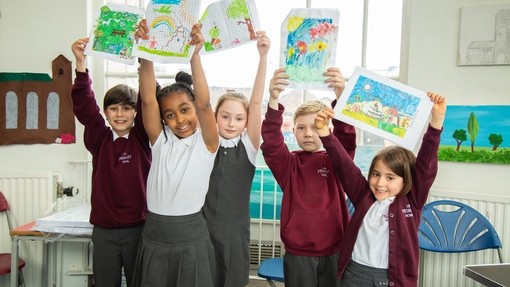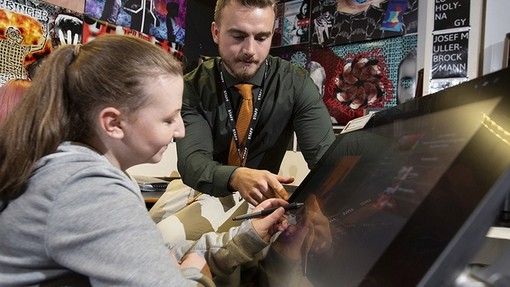
How to embed creativity across an academy trust with Artsmark
Content
Putting creativity at the heart of a school is challenging - here one trust explains how it successfully embedded the arts
As the cultural enrichment officer for the David Ross Education Trust, it is my job to ensure that the cultural arts are embedded across our 34 primary and secondary schools, so that our students have a wealth of creative opportunities. But it isn’t without its challenges.
It has taken more than three years to write and implement our arts programme. We used our in-house music experts to build an entirely bespoke music curriculum, designed to build the core knowledge required for a positive and fruitful experience of music in its many forms and timetabled within the school’s lesson structure. In the development of the rest of the curriculum, I saw a clear role for the arts in supporting day-to-day learning. The vision was that academic studies would be enhanced through the use of cultural and creative stimuli. English could be enhanced by drama; maths and music could go hand-in-hand; and even dance could be applied to history, religious education and science. Our aim was to provide alternative creative methods of teaching in our schools.
Artsmark has been instrumental in embedding the arts into the daily lives of our schools: 82 per cent of them have now registered. The simple process saw each of our schools preparing a Statement of Commitment, focusing on how creativity and the arts can underpin school improvement plans and the specific ambitions of each school. One trust, for example, identified that its pupils were of a majority white British background and understood their curriculum requirements to impart a wide and diverse experience of different cultures. Through the Artsmark process, the school pledged to work with artists of different cultures and brought in workshop experiences in Australian aboriginal art, African tribal drumming and Chinese celebratory artwork. Another school identified the need for better behavioural management techniques. Dance lent itself perfectly to this cause, as they worked with dance artists to devise a cool-down routine inspired by aspects of yoga, which would calm an agitated pupil, making them more receptive to communication.
The arts boost wider pupil attainment
Artsmark is awarded at three levels: silver, gold and platinum. To achieve Artsmark Platinum, schools should have an appointed arts governor, something which inspired us. We appointed a member of the board at each school to be responsible for keeping up to date with the latest Artsmark-related developments while having a working knowledge of their individual Statement of Commitment. This gave the arts an additional voice on the board, to speak up when questions arose around spending, teachers’ time and resources, and to attest to the advantages of creative pursuits.
The trust’s dance programme launched in 2016, in our northernmost cluster alongside the Hull City of Culture. The aim was to provide our primary pupils with a movement-based art form that could be used as a teaching tool as well as a creative outlet, enabling them to choreograph and perform a unique piece.
We started by training each school’s designated dance lead with a tailor-made CPD session. The focus was on real learning through a real experience of the art form, imparted by trained, motivated and enthusiastic staff. We quickly found that our cohort of trainees was coming up with ideas to teach various topics through movement. They took to the idea of teaching a lesson on the planets by designating pupils as astral bodies in the school hall and having them simulate the movement of our solar system’s pattern of orbits.
These sessions were pupil-led, emphasising and strengthening creative ability and ownership. To those pupils who showed an affinity or interest in the dance, an additional opportunity existed in the formation of a school dance troupe. Following the theme of the City of Culture, our schools involved the community, and invited people in for a sneak preview of the performance that would later be shown at the trust’s summer dance festival.
The dance programme is entering its third year now and has expanded to our central and southern clusters, including secondary and SEND schools. It stands as a testament to the ways in which arts can run alongside a formalised and academic curriculum, strengthening and enhancing its delivery.
And all of our schools have started to see the benefits of combining the curriculum with arts; students are more confident in school after performing on a stage, be it for a school play or a rehearsed dance piece. They show a marked improvement in their oracy abilities, for example, after performing in the Shakespeare Schools Festival. Many schools reported an increase in attendance on the days with a lot of enrichment activity, and, as a result, those pupils who struggled in attainment actually improved in performance against formal testing criteria.
I was intrigued by these claims and conducted an internal case study on a primary school within our trust, which I knew was accessing our enrichment programme considerably. I examined the test score data for age-related expectations (ARE) from 12 pupils as they progressed through Year 5 and compared this with each pupil’s participation in extracurricular activities. As expected, those who engaged in four or more extracurricular activities throughout the year consistently scored higher than their ARE.
With the introduction of the EBacc, all schools are confronted with the constraints of time and priority. It is, therefore, the responsibility of artists and educationalists to adapt and evolve in such a way that the arts and Stem subjects can coexist, interweaving the two so our pupils develop the skills to be critical and creative people.
James Healy is the cultural enrichment officer for the David Ross Education Trust


